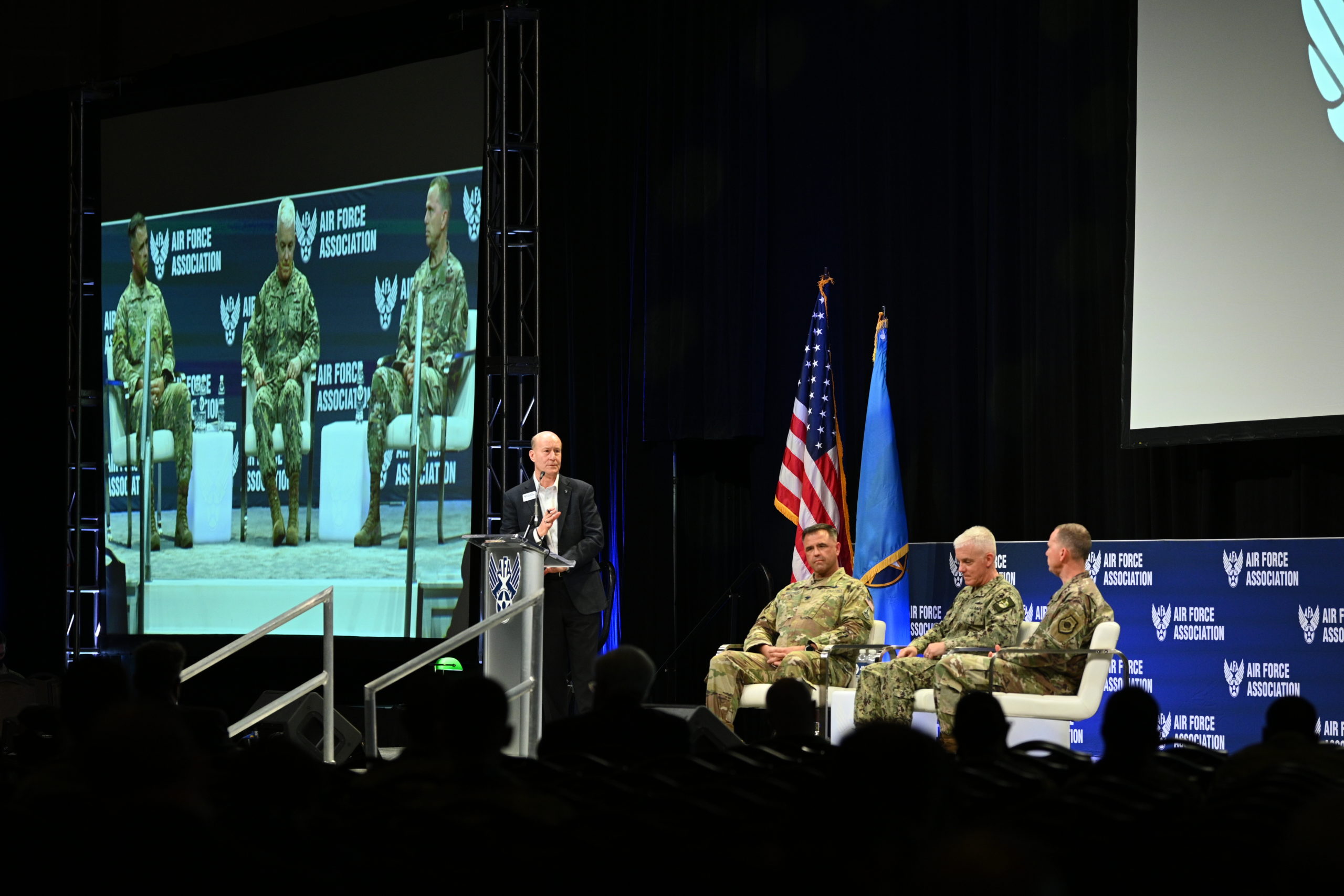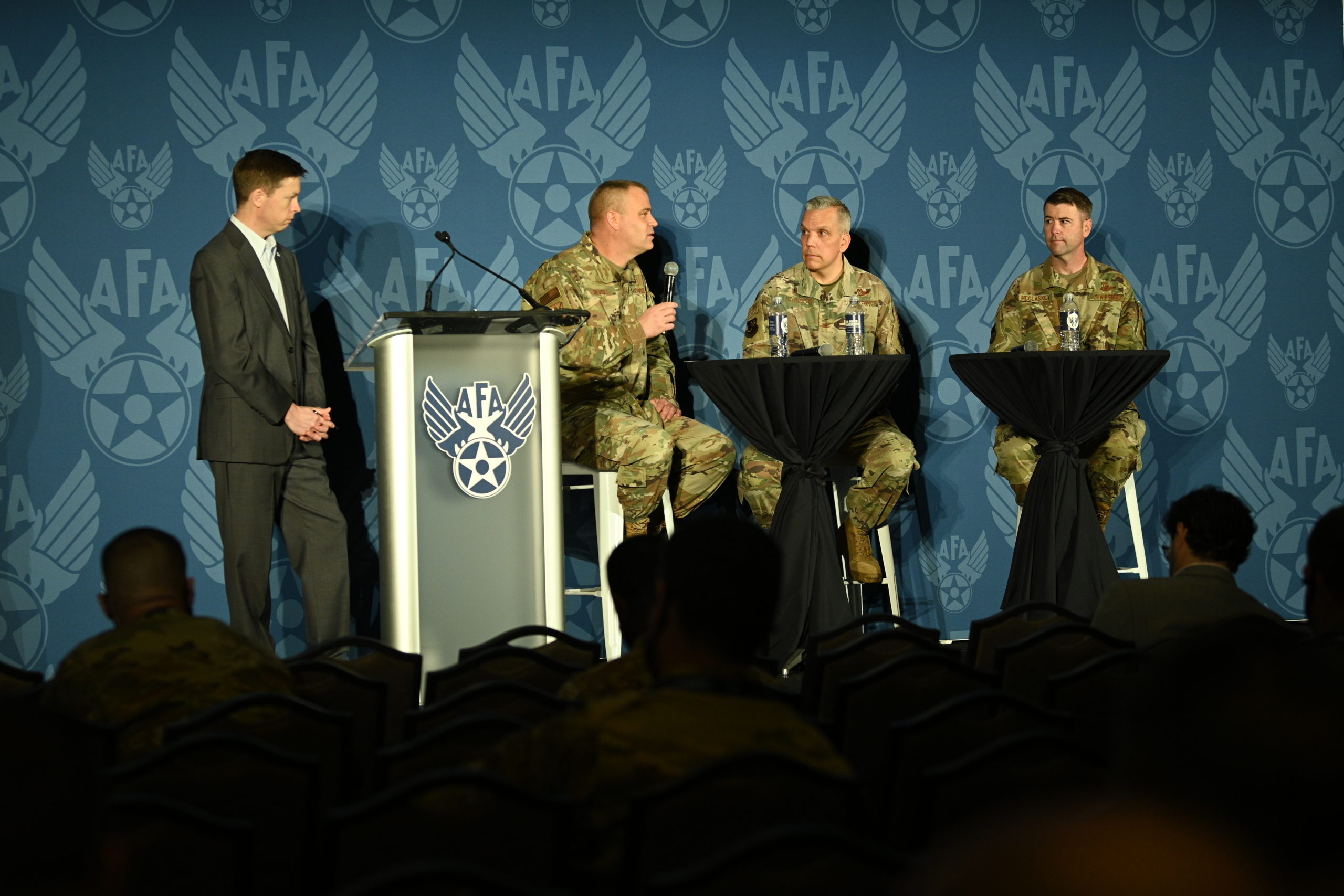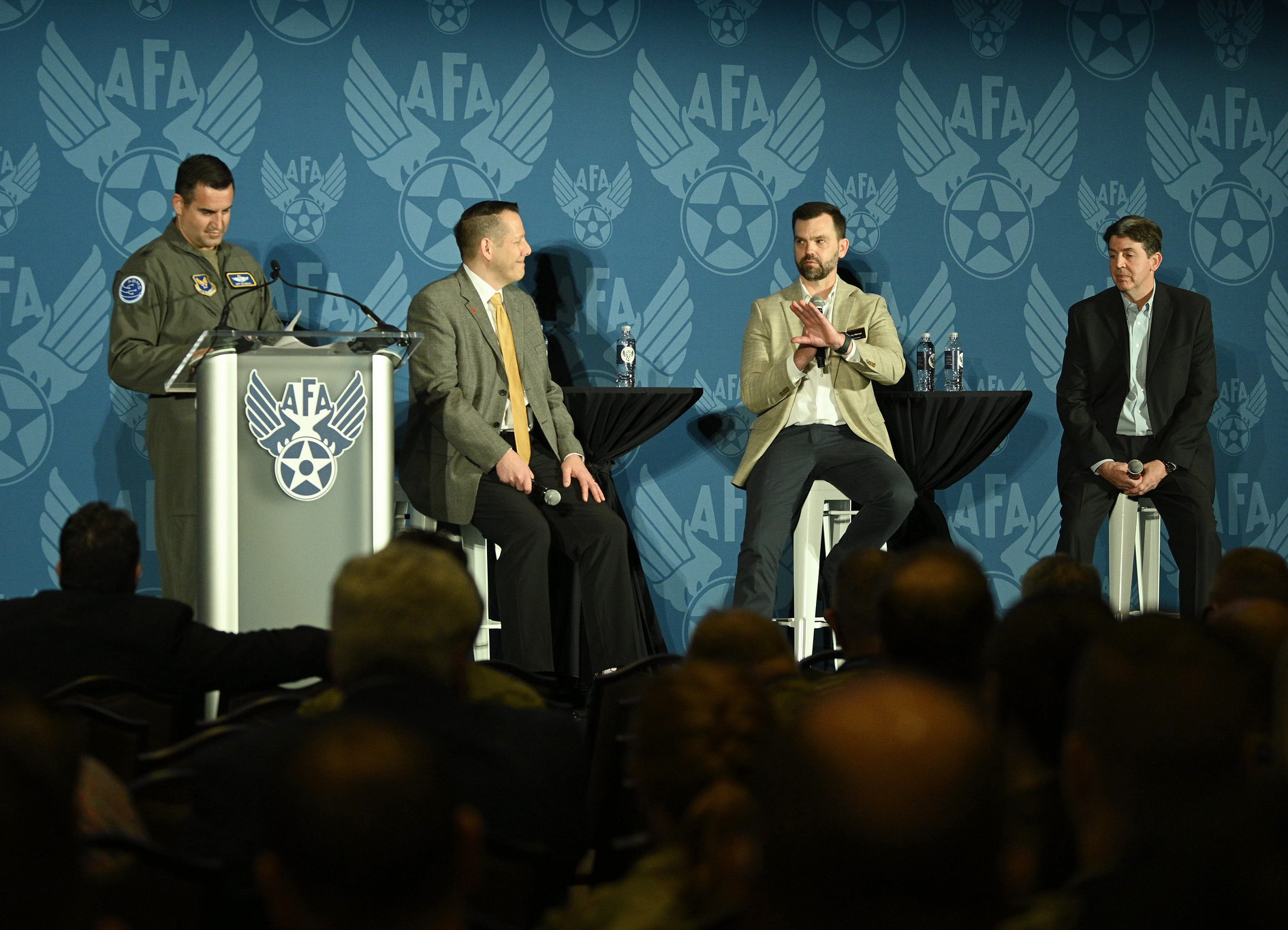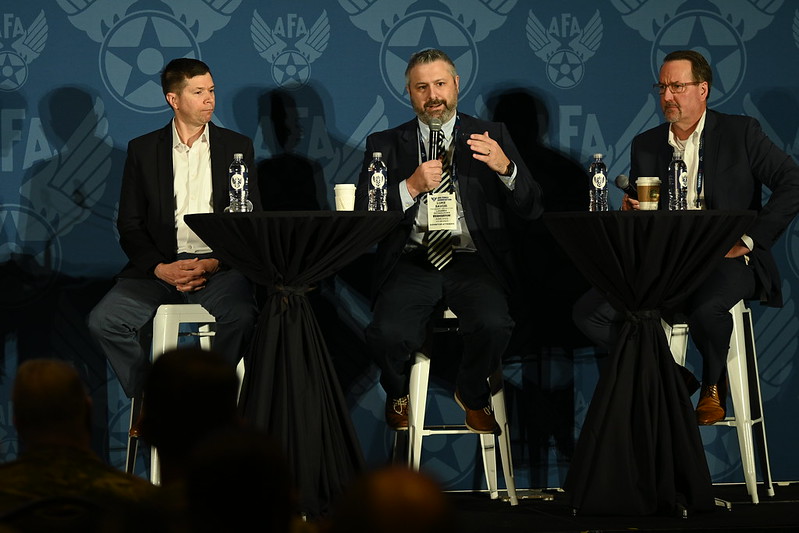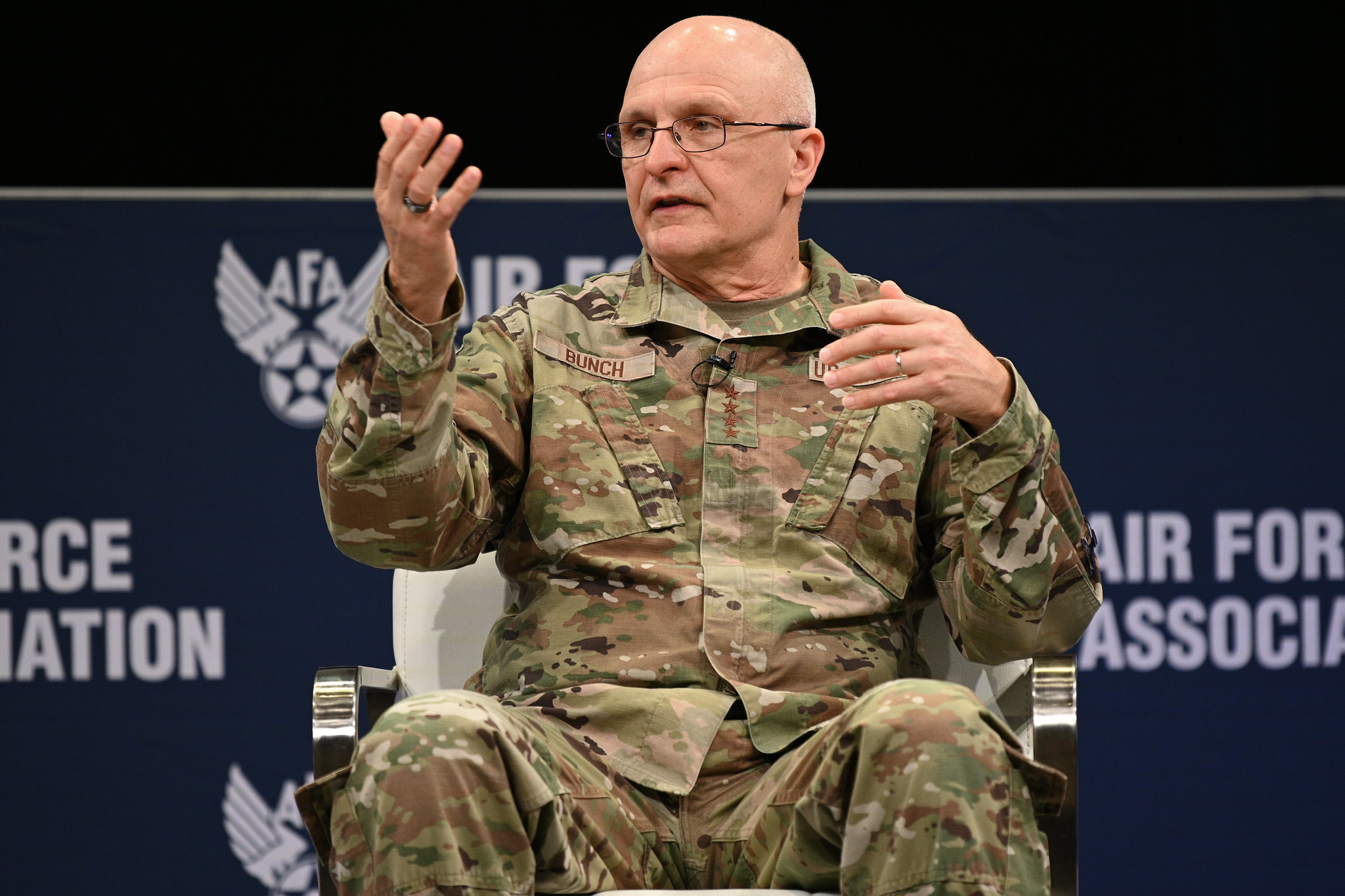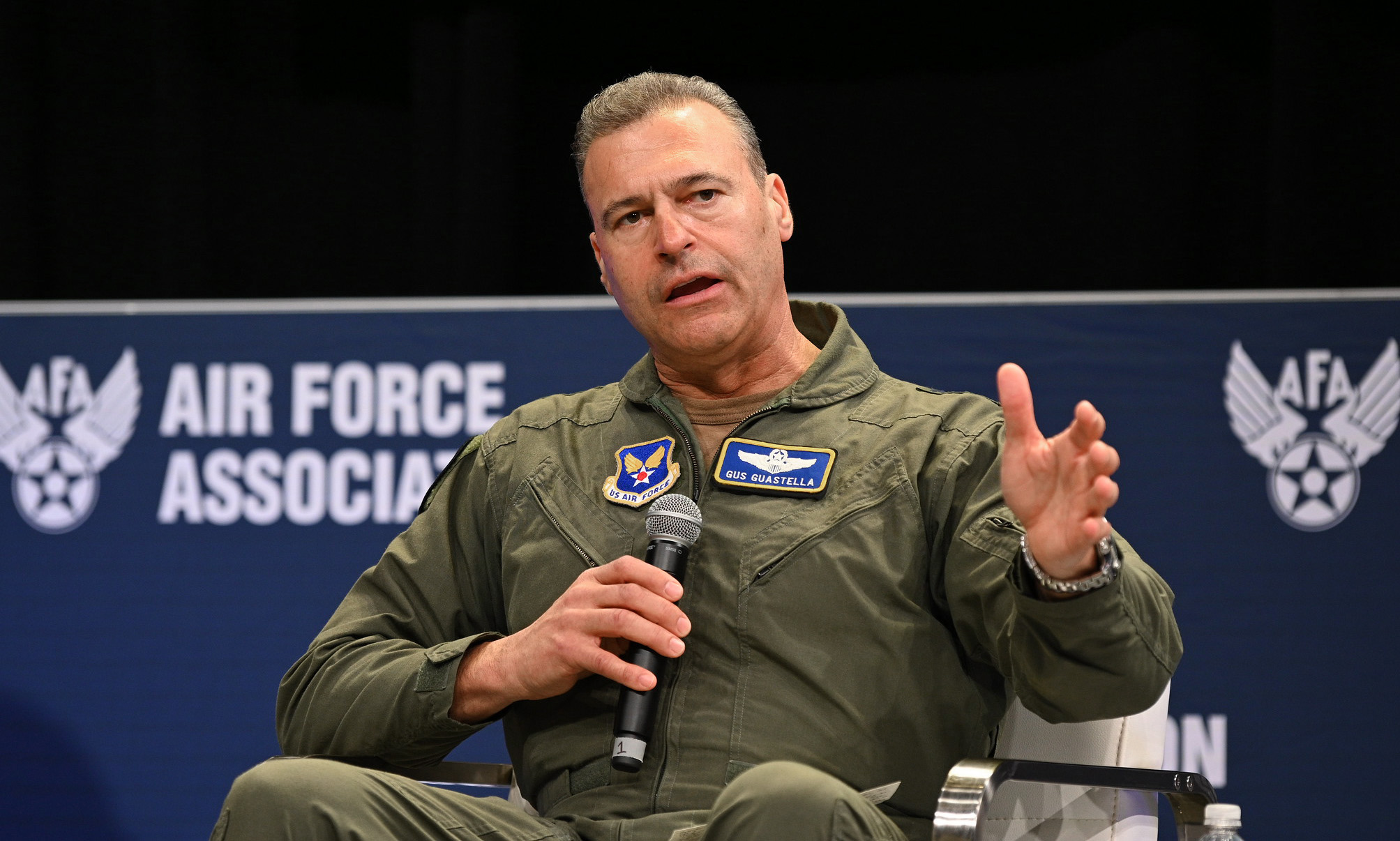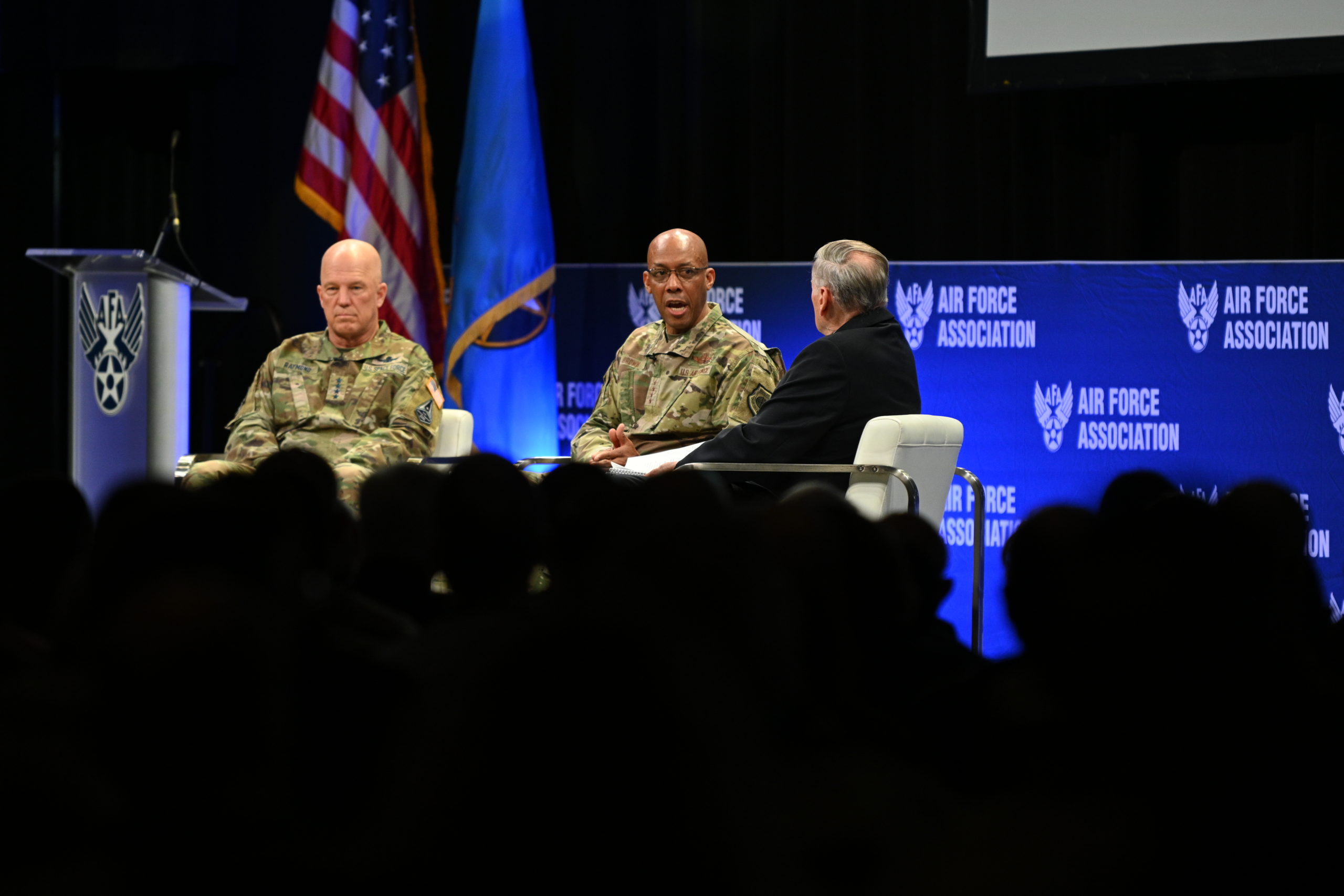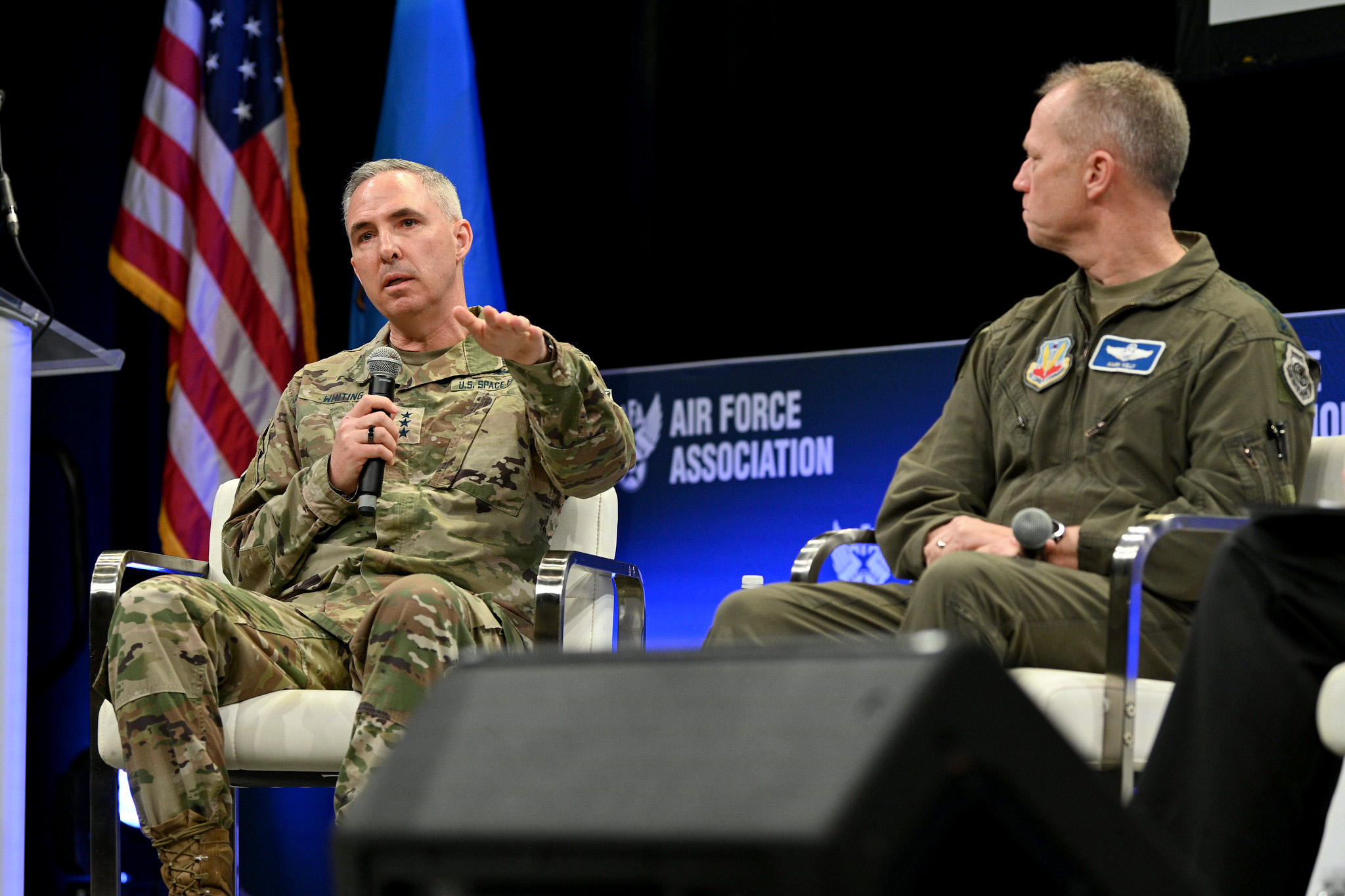Lt. Gen. Jim Dawkins, Air Force deputy chief of staff for strategic deterrence and nuclear integration, hosts Jim Kowalski, vice president and corporate lead executive of Air Force Customer Relations Team at Northrop Grumman; Paul Ferraro, president of airpower at Raytheon Missiles and Defense; and Christine Jeseritz, director of nuclear command, control and communications with Lockheed Martin, to discuss nuclear modernization at the AFA Warfare Symposium on March 3, 2022. Watch the video or read the transcript below. This transcript is made possible through the sponsorship of JobsOhio.
Lt. Gen. Jim Dawkins, Air Force deputy chief of staff for strategic deterrence and nuclear integration: Well, good morning. My name is Lt. Gen. Jim Dawkins. And I’m the Air Force’s deputy chief of staff for strategic deterrence and nuclear integration. And I’m hosting today’s nuclear modernization panel. Before I get started, I’d like to thank AFA and our industry partners for hosting such a great event. In my role, I am singularly focused on ensuring that we advocate for the needs of nuclear enterprise. One of my primary roles these days is advocating on the need for nuclear modernization. We’ve heard a lot about threats yesterday. We heard about pacing threats and strategic competitors. We see it on the world stage every day. The threat is real, whether we’re talking conventional or nuclear. Just a couple of data points, though, on the nuclear front.
With regard to Russia: Russia is over 80 percent complete with their nuclear modernization programs. More worrisome is that they’ve delved into novel nuclear weapons concepts and capabilities, things that we don’t have an answer to other than a strong deterrent that we currently have today. Those novel weapons are not covered by any treaty, at any rate, not covered by New START, or anything like that. And that causes us great concern. Turning to China, you’ve heard Adm. Richard and others talk about a breakout, a strategic breakout. Really what that means to the everyday person is that China’s gone from being a lesser nuclear state to having a couple 100 weapons to a state that’s projected to have over 1,000, or up to 1,000, nuclear weapons by the end of the decade. That’s a rapid growth. We’ve seen it in open source intel, how they have gone on a breakneck pace to develop ICBM launch facilities in their country.
And again, that is what has caused us a lot of pause and concern from STRATCOM. For the first time ever, we are deterring two peer nuclear competitors. That has to change how we look at the world. Well, the U.S. just started our modernization journey, or we’re in the beginning of it now, just fielded, or again, started to produce with NNSA, B61 Mod 12. We’re taking the 1970s Minuteman III, designed for 10 years of service life; it’s been extended for 40 to 50 years now. And we’re transitioning or we’re going to transition to GBSD at the end of the decade. We’ve got a 1950s B-52 flown by several generations of people in some cases. And we’re going to modernize that with new engines, radar and comms suite. We’ve got a 1980s B-2, and we’ll be transitioning to a B-21. Our 1980s Air Launch Cruise Missile will be transitioned to the Long-range Standoff missile.
And of course, all of this is underpinned by an NC3 system that is very old and has been modernized as we go and as we transition to what we call next-gen NC3. The challenging piece is that we’re filling all of these systems or modernizing all these systems simultaneously. And they will be come into play toward the end of the decade. That includes the Navy’s Columbia class. So all three legs of the triad are being modernized at the same time. And we don’t have a lot of margin after a lot of extra time here for program slips or delays or things like that, because we have to keep what we currently have safe, secure and reliable as we transition to more safe, more secure and more effective systems that can meet future threats. The sense of urgency has never been more important.
If you’d asked me a year ago, I would have said the same thing. But Ukraine has brought that into sharper focus. Time-certain delivery is required, and what that’s going to take is a joint team between the Air Force and our industry partners, represented by the three panelists to my left. We are guided in our work by Christine Jeseritz. She’s the director of nuclear command, control and communications, or NC3, as we call it, with Lockheed Martin. To her left is Paul Ferraro, president of airpower, Raytheon Missiles and Defense. And finally, Jim Kowalski, vice president and corporate lead, Air Force customer relations, government relations with Northrop Grumman. What I’d like to do, we’re going to start off with brief opening comments from each of the panelists and then go to three rounds of questions. So Christine, over to you.
Christine Jeseritz, director of nuclear command, control and communications with Lockheed Martin: Thank you, Gen. Dawkins, for allowing me to be a part of this panel and talk about how industry and government can collaborate on this important issue. In many ways, NC3 represents the final phase of reinvigorating the nuclear enterprise, and I believe the most critical. But how do we tackle this problem? It’s very large. I’d offer four thoughts. First, we have to be willing to change. Change is not a technology problem. It’s a psychology problem. People fuel change and sustain its momentum. We need to look at the policies and processes and procedures and ask, ‘Do they transcend architectural decisions, or were they the result of implementation of the system at the time?’
Next, we need to subdivide the problem into smaller pieces: a comms layer and a processing tier. The comms layer today did not benefit from an enterprise architecture that was ubiquitously connecting assets. Why? Because commercial tech was a rotary phone, and comms as a service was a party line. Our spot in the technology continuum allows us to connect all these intergenerational systems together to provide that foundational layer for the processing tier. The processing tier today relies on preconnected circuits, and data aggregation was the net-centric dream. We now have the means to aggregate the data and distill that data into important information for the war fighter.
Next, we need to infuse technology. Adm. Richard says, ‘NC3 fits hand in glove with JADC2.’ And we need to make sure that we introduce the technologies that we’ve been doing in JADC2, like 5G.mil. And then once we have that super connected weapons system, we can aggregate the data into cloud technologies and use AIML to distill information to have optimized course of action plans. And then finally, we need to garner funding support. But how do we get decision-makers to prioritize electrons through wires and algorithms? The experts in marketing intangible products offer a couple of thoughts. First, humanize the product. Have operators that use the system day to day be able to provide testimonies. And through digital engineering, we can then animate the problem, demonstrate through movies what they’re feeling today and how the modernization can really help.
This is a difficult problem. But we’ve been here before. And I have optimism that we will attack this modernization with the same fortitude that built the system that’s kept us safe for decades. Thank you, and I look forward to the questions.
Dawkins: Thanks, Christine. Paul, over to you.
Paul Ferraro, president of airpower, Raytheon Missiles and Defense: Thank you, General. Thank you for the opportunity to speak this morning. So the National Defense Strategy and the Nuclear Posture Review are yet to be released. But as the general mentioned, I don’t think any of us are going to be surprised when we see China and Russia prominently mentioned in each of those documents. Regaining and maintaining our ability to deter and defeat near-peer threats like China is a top priority for the United States Air Force, and its industry partners are top priority of ours.
Continuing modernization of the triad is central to that strategy. Each leg offers a unique element of the nuclear triad, and each are equally important. The sea leg offers survivability. The land leg, or the ICBMs, brings responsive deterrence and deterrence in numbers. And then the air leg provides a visible and flexible response, and that visibility and flexible response can compel behavior internationally. With respect to the air leg, LRSO provides the nuclear triad’s modernization hedge—the gap if you will or gap filler if you will. The program provides unmatched visible, credible and strategic deterrence. Rooted in nuclear assurity, it must be safe, secure, reliable and, above all, survivable.
And that’s what LRSO, or the Long-range Standoff program, does. The program is progressing well. Since its earliest inception, since it was a New START program, we’ve infused model-based systems engineering and digital engineering and truly have designed it not only to meet the stringent performance requirements of the weapons system itself, but designed it from the earliest phases of the program for producibility and, equally importantly, maintainability. We’ve undergone a very successful and extensive ground and flight test program throughout 2021, and that test program continues today. And again, the focus on maintainability throughout the lifetime has been paramount as we design this program. We’ve entered the EMD phase following TMRR phase approximately eight months ahead of the original baseline program, and to this day, we maintain the eight-month margin.
So critical to maintaining our need to fill this capability as quickly as possible is going to be maintaining and securing the presidential budget request for both ’22 and ’23. And allowing us to maintain that accelerated scheduled performance as we headed to both milestone C and then ultimately IOC. With that, sir, I’ll hand it back to you.
Dawkins: Thanks, Paul. Jim?
Jim Kowalski, vice president and corporate lead executive, Air Force Customer Relations Team, Northrop Grumman: Thank you, Gen. Dawkins. You know, one of the fundamentals about the world, and there’s a lot of comments about a new Cold War, about the rising threat of China, but the fundamentals of deterrence have not changed. And it’s about an adversary’s perception of our will and our capability. And by not only modernizing the triad, but recapitalizing, replacing with new systems designed for the 21st century, using 21st century tools, using 21st century concept of operations, not only puts the marker on the table for pacing the threat with capability, but just as importantly, if not more importantly, it shows that the will of the United States to remain the responsible global leader is still there. And you get both of those by recapitalizing the force. This is foundational to everything we do. One thing that we used to say is that when the secretary of state walks into a room with an adversary country, or an ally, the gorilla in the room back in the corner, that 800-pound gorilla, is our nuclear force. Thanks.
Dawkins: So, now to Round 1 of questions. So, Christine, the addition of NC3 as a line of effort within JADC2 is critical to ensure reliable communications and information sharing across all domains and competition continuing. How do you see the relationship between conventional C2 and C3 and NC3 evolving the development of JADC2 the pursuit of conventional nuclear integration? A lot of things we threw at you there, a lot of acronyms, but tell us how you’re going to make it happen.
Jeseritz: That’s OK. I can do this. The investments that we’re making in 5G.mil, band-agile comms and zero trust networks really encompasses both requirements and needs that NC3 has, as well as JADC2. It encompasses the needs that both systems have. And day to day, NC3 really operates in a fairly benign state. But it also has to remain survivable through conflict. And so, traditionally that survivable line between the president and the nuclear forces has been called the thin line. Today, we have the technology to be able to thicken that thin line. And as we go into conflict, we’re going to expect deprecation in that communication infrastructure. And so we’re also working with key business partners to provide persistent communications through contested and denied environments in order to deliver those important messages to the shooters.
Additionally, we’re looking at AI and ML solutions. Because once everything is connected, you then can have data aggregation and operate on that with AIML. You’re able to distill large quantities of data quickly and really be able to get after increasing that decision-making timeline for the decision-makers and senior leaders. And so that’s how I see them going together.
Dawkins: Yes, thanks. That decision-making timeline, giving them more time to decide, is truly a key piece of this as we go forward. So thanks for that answer. Paul, so during your discussion on LRSO, you mentioned design for manufacturing and design for maintainability. And we discussed this the other day as well. How does Raytheon maintain this balance?
Ferraro: It’s a very unique program in this regard. As I mentioned, since its earliest inception, we’ve used model-based system engineering and digital engineering processes and this program, again more than any program that I’ve had the opportunity to be involved in throughout my career. We fully modeled our factory floor and then included that into our design process. Since its earliest phases, it’s beginning with our first flight-test vehicle and ground-test vehicle, all of our test vehicles are being built on our factory floor using factory personnel, factory procedures, factory processes, collecting the units, if you will, and productions, metrics that we use to enhance our cost model and build our cost model with an eye toward manufacturability and recurring cost. But perhaps even more importantly, as the general mentioned, the life expectancy of these programs is decades, and building these systems for maintainability throughout that lifetime is absolutely critical.
So, to that end, very early in our design phase, we brought in the Airmen from Vandenberg, Minot, Tinker and Barksdale to partner with our design team, the design team that oftentimes doesn’t work with the logistics folks and the maintenance folks, and really inform the design process and inform some of the design attributes. We went so far as 3D printing a translucent model of the missile itself, ran the wiring harnesses through, put in mocked up versions of our line replaceable units and asked the Airmen to go and perform the maintenance procedures as they were drafted at that point and really took note of what worked, what didn’t and where we needed to modify the design so that it would be maintainable as intended throughout the lifetime of the product and then updating our cost model accordingly to really optimize the life-cycle cost of the weapons system. So pretty exciting stuff.
Dawkins: Oh, that’s so important. You know, as I mentioned in my opening remarks about how many of these systems were designed for maybe a 10-year service life to include the ALCM and, of course, the Minuteman III, and they’re decades beyond that, because based largely due to the Airmen that are carrying the weight of this work on their back day in and day out, working the supply chain issues with your companies, to continue to find those vendors to be able to produce those old systems. And that’s becoming more difficult every day. And I’m happy about your comments about designing this in for more than a 10-year life, if you will, and making these things more or easier to sustain for those Airmen so they don’t have to come up with new ways to do things on the fly, that they’re actually doing processes that have been proven out with folks on your team. So thanks for that.
Jim, over to you. Today’s global security environment appears to be very different from that at the end of the Cold War. How has this affected the modernization of our nuclear forces?
Kowalski: Probably the biggest change, and this is at the national level, and it really isn’t so much a change as it is an improvement from our perspective, and that is growing bipartisan support in Congress. There’s a recognition of the threat by Congress, and they’ve enacted their … or acknowledged it as they proceeded with the budget. So not only have they agreed to modernize the programs and agreed to retain the triad, but they’ve agreed to recapitalize GBSD. And that’s a big and important step, and the result of that is that we put stability into our program, which long term keeps it on time. And that funding stability also preserves the workforce and allows us to grow that workforce. And it improves the morale of the people in the program, both on the industry and government side, and in my mind improves the morale of the Airmen and the folks that are out there in the field, because they see their nation cares about what they do.
The other place that I think this has an impact is this idea of a sense of urgency behind how the global situation, global security environment, has evolved over the last seven or eight years. In particular, we’ve had a number of the senior leaders who are responsible for this mission set, responsible to defend the nation and provide that nuclear deterrence, go to the Hill, go to the media, go out to think tanks, walk the halls of the Pentagon. And they’ve carried a consistent message, and this would be from Gen. Hyten, Adm. Richard, Gen. Ray, Gen. Cotton, and that message has been, ‘We have no margin left. You have to do this program now. We can no longer afford to sit back and do another study and wait a few more years.’ That, in turn, has this sort of a drumbeat of a sense of urgency into the programs. Now there’s limited ability of government and industry to accelerate a program.
But by golly, we’re gonna stay on this schedule. And you can put discipline into both government and industry when everybody makes it clear that the schedule is priority one. And that in turn, and I’ve seen this over my last six years with Northrop, is it has actually driven a culture shift in some programs, where they’re not sitting on opposite sides of the table negotiating every line of a contract. They’ve got the communications and transparency and common goals. And they’re figuring this out together. So that kind of partnership and that kind of trust is really critical. So I think, you know, those, the global security environment has reawakened a lot of folks to the importance of this enterprise. Thanks.
Dawkins: Thanks, Jim. And to your point, you know, I see that every day when I go and talk to staffers or Hill members, as well as engaged with think tanks and others. Once you get them in the room and explain to them what these programs are and the history behind the current programs, they have a better understanding. I mean, we’ve got broad bipartisan support on the Hill. And I’ll say it, again, broad bipartisan support on the Hill for the nuclear modernization programs, both of the Air Force and the Navy. But it’s going to take that constant communication, because more than once I’ve heard with regard to GBSD and Minuteman III, ‘You mean it’s more than just a simple missile swap?’ Yes, it’s more than just a simple missile swap. It’s all the launch facilities and all the C2 and all the alert facilities, all that in LFs being modernized, all that goes into GBSD. And it’s important to keep folks tracking on the context surrounding the modernization we’re about to do.
So, Christine, you talked about hypersonics. And we’ve talked about other novel weapons that are out there, AI and machine learning, and how that can cut into decision timeline, particularly the hypersonics that national leadership has to be able to make a smart decision on how to, whether or not to employ nuclear weapons or other strategic type of capabilities. So what are some of the concepts and some of the solutions that we can be pursuing now to accelerate communications and increase decision space through complex and shortened timelines?
Jeseritz: Sure, the orthogonal relationship between detecting that fast-moving threat, that hypersonic threat, against the need to elongate that timeline is truly a difficult problem. And, you know, it’s gonna require some different ways to think about how we sense the problems of our sensing tier, as well as make us a lot more dependent on data aggregation, and AIML type of technologies in order to distill very large sums of data. So as we move forward with this, we can we can look at the sensing tier and look to figure out how we can use additional sensors. We have to increase the amount of sensing surface that we have in order to be able to track this threat properly.
So we can consider commercial sensors or even government sensors that are in the ground, air and space tier. This will require some policy changes in order to accept the observations from these nontraditional sensor sources into the algorithms that eventually confirm and type the threat. Additionally, we’re going to become more dependent on higher volumes of data. In order to distill that data into information that’s meaningful to the war fighter, we’re going to use AIML to do so so that we can optimize the O plans going forward.
All of these things together really help to shrink that processing timeline and elongate the timeline for the decision-maker. And kind of foundational to this, and others have talked about this this morning as well, we really need to have digital technology to tell us as we’re making this modernized system, what are the second, third and fourth order effects from a systems of systems perspective, and so we need to have digital twins so that we can do that and really make the best decisions as we move forward in this modernization.
Dawkins: Thanks, Christina. A key point there, I think of what you’re getting at as well as resilience, we want resilience in our NC3 architecture in to be able to do in C2 over a host of different types of systems. We want to leverage what we can from JADC2. Why spend double money on two different systems? And we don’t today. We use, you know, conventional command and control systems even today for this mission space. And we have special carve outs for the hardened nuclear comms as we degrade from the thick line as you call it to the thin line. That’s the same thing that we’ve been trying to get people to understand with JADC2 is that they take what we can from JADC2 and have a carve out for specific thin-line-type things. I know that Gen. Cotton and Mr. Stevenson up at STRATCOM are working hard on these these architectures.
So, Paul, going over to you a little bit more on digital engineering and model-based systems in engineering, there are key components to Air Force acquisition now. That seems to be the wave of the future force. How’s Raytheon meeting those requirements?
Ferraro: Requirements for model-based system engineering?
Dawkins: And digital engineering.
Ferraro: Digital engineering. Well, I mentioned earlier some of the work that we’ve done to design our factory floor and how we very early on adopted a very high-fidelity cost model that captures not only the cost of the unit itself but the life-cycle cost and really fold it in the expert opinions and feedback that we received from the Airmen that inform not only how we’re going to maintain this system throughout our procedures and tooling and test equipment, but really informed the design at a very early stage, make sure that was we’re very mindful of that with our design team, who oftentimes doesn’t have that direct interaction with the Airmen who maintain these weapons systems throughout their lifetime. But also, digital engineering and model-based systems engineering really allows us not only to move faster through the development cycle but really augment what has classically been our testing evaluation program.
So I mentioned earlier that throughout 2021, and continuing 2022, we have our ongoing ground and flight test program that is well underway and will continue to inform our design and assess our performance through that. But equally important, if not more important, using model-based systems engineering is the flight simulation capabilities that we have. So again, we have a very high-fidelity model, or digital twin, of the model itself or of the missile itself. And using DevSecOps in an agile environment, we’re able to upload new versions of software almost daily and essentially fly our missile in a virtual environment upwards of 6 million miles an evening. And we fly it in a representative theater environment to really exercise the system itself. Find out there’s a software work the way is intended. How does the overall system perform? What’s it survivability? Were the objectives met? Share that information real time, not only with our overall design team, but with our Air Force partners and leaders, and collectively decide how do we modify the design from here. How quickly can we can respond to what we’ve learned, can we anchor on models when we did. Then we do go to a flight test and really augment that program in a very, very meaningful way. So not only are we moving faster, we’ve developed a much more robust, much more robust process, and design capability.
Dawkins: Thanks, Paul. And you mentioned software, you know, with our current systems, it was all about hardware. And today, it’s becoming more and more about software and making sure you have software engineers that can write the code fast enough for the hardware development. So that’s just a key component of all of our systems that I get to be exposed to. Jim, a little bit more on the digital engineering from Northrop here. Is it important to nuclear modernization and why?
Kowalski: As we’ve already talked about here, it completely changes how we do a lot of business. Digital tools, digital solutions, allow us, first and foremost, to reduce the risk. And by reducing risk, you get more confidence in your schedule. You’ve taken things that could have been problems out in the future that would put the time back in a schedule, and you solve them ahead of time by doing things in parallel. That in turn, because you’re not going to be wasting time redoing work, that’s going to reduce your cost. And then one of the most important things as we face a world where we’re dealing with China as our primary competitor, is we’ve got to be able to upgrade our systems faster.
And one of the key things that digital tools, digital solutions, does for us is allows us to get a much faster cycle time out there. So when we talk about the B-21: The B-21 has been using digital engineering since day one to design, test and build out that system. And then what that has given the B-21 is it’s allowed us to build that airplane much faster and, at the same time, be able to keep it up to speed with the pace of the threat so that when it is fielded, it’s going to be a fully capable airplane. And those of us who’ve been in this business for a while know that normally when you field an airplane, it’s out there with a baseline capability. And as you learn and train with it, you slowly grow and add things on, and we see, you know, the major command that owns it finally get it up several years later to what we call a full operational capability. Well, we don’t want to be doing that with our B-21.
And one of the important things here is that that idea of rapid upgrade ability not only in the design and build process but after the airplane is fielded. So by using DevStarOps open-mission systems, we can get away from, I know Global Strike doesn’t want to do block upgrades; they don’t want to have a list of things to put on the airplane to update or upgrade and then go through 18 months or a two-year process, and then all of a sudden, they get that upgrade. They want it to look like your phone, where there’s an update, and it happens in the middle of the night. And your phone is better as a result of that upgrade. You know, we see a lot of companies out there doing that. That’s driven a lot by that idea of DevStarOps and agile software to be able to do that kind of upgrades so that when we can not only do it virtually instantaneously, but when you get to bigger upgrades, for example, weapons, we’re able to do it in months and not years, and that’s huge.
On GBSD, GBSD is the first program to get the E program designation from the Air Force because of its use of the digital tools, digital engineering and open-mission systems and those digital architectures. GBSD has also been recognized by the acquisition community in a recent biannual report for their use of digital twins and modeling, not only to make decisions within the program, as they’re moving forward, but also to start teasing out that digital thread so that we’re not just being digital while we’re building the platform, but we’re going to carry through those digital models and digital twins, we’re going to carry that digital thread forward into training, sustainment, maintenance, all the aspects of how we do that. And then once it gets out in the field, our Airmen are going to tell us what else they need and how else we can use it. So, you know, I think we’re, we’re making great progress with that.
Dawkins: Thanks, Jim, those risk-reduction efforts I’m seeing across our industry partners. And that’s definitely been a, I think, a big win. Again, allowing us upgrades faster in an open-mission system architecture, I think, is another key piece of this to allow others to plug and play and determine how best to integrate with the systems.
So, Christine, and this is our final round here. We talked about all three legs of the triad been modernized simultaneously. So the challenge I see, and I’ve been talking to folks like you, how do we ensure that NC3 is able to keep up with that and maintain our reliable access now and be able to transition into the future?
Jeseritz: Yeah, truly NC3 is, you know, the fourth leg of the triad and is the Manhattan Project of our time. And it’s going to require the same results-based tenacity to solve. And as we look at the triad being modernized, there’s an asynchronous modernization to that. They’re not all coming due at the same time. And so I’d offer much like we’ve been talking about here today is that digital engineering can also help us chart that path to a transition plan. So through modeling, we’ll be able to understand how we can modernize things the quickest in the comms tier and the processing tier to optimize the solution. And as we move forward, there’s certainly, you know, complexities. And across the industrial base, we have all of the knowledge. And so something that I’d also like to offer is the thought of perhaps using a national team approach. The complexities of this and certainly the knowledge base, if there’s clear governance, we can really be a force multiplier in modernizing this and maintaining that good continuity of operations as we do so.
Dawkins: Thanks. And that is going to be the, I guess, the Manhattan Project of our time, as you talked about. Just linking all this together, there are 204 NC3 systems; Air Force owns about 70 percent of that. It’s space; it’s ground; it’s airborne. It covers all the regimes there.
Paul, turning to you, you mentioned the Nuclear Posture Review. We heard our chief talk about continuing resolutions. How does the company work through that, you know, with those unknowns?
Ferraro: Well, like all of us, we’re interested in Nuclear Posture Review, and when it’s published, we’ll certainly dive into that and make sure we understand the implications of that as that’s going to define our national policy with regard to nuclear modernization. So we’ll await that publication, the availability of that document. Regard to CRs, the reality is we’ve been here before, and the good news is I think we’ve learned how to work through it, sometimes more gracefully than other times. But I think this really speaks to the partnership that we as industry partners need to continue to maintain and bolster with the Air Force. And, you know, as with any program, there’s always three elements that need to be managed: cost, schedule and technical performance. And in this case, I have never seen a situation where all three are so vital and so critical to our national security. We need to deliver the capabilities that were asked to deliver. And we will certainly maintain our focus on technical performance. Cost is paramount; there is no more money, and we simply don’t have the resources that we need to do all the things that must be done. But schedule is paramount. And as an industry partner, teaming with our Air Force counterparts, we will certainly bring to bear all the resources that we have available to maintain schedule and make sure that we deliver these capabilities on or ahead of schedule.
Dawkins: You know, something that I think is really important here is the stable requirements piece of this. And as the Air Force, we’ve got to make sure that we have stable requirements and we don’t continue to try to change things right now. Right now, we’ve got, I think, we’ve got those locked down pretty well. And then the teaming aspect, I think it’s really important with the program managers and PEOs. And I see that when I go out to visit with them.
Jim, our final question. Again, you mentioned this a little bit. You’re working two of the Air Force’s largest programs, and they are for nuclear modernization: the B-21 and GBSD. What have been the key challenges?
Kowalski: Well, there’s certainly no shortage of challenges in any large acquisition program. And, of course, we’ve seen, you know, COVID and workforce and continuing resolutions have been out there. But what I mentioned at the beginning was that drumbeat of what’s going on in the world, that drumbeat of we’ve got to have a sense of urgency here. How do we put the speed into the program. And really, digital engineering, and to circle back to that one more time, has given us the ability to design, test and build this bomber, or the ball of these weapons systems faster than ever before. And we’ve put ourselves in a position where we have the ability or the potential to take a bomber or a missile from contract award to initial operational capability in less than a decade. We have to stay on that track.
And what’s important for us here is to not only acknowledge that there’s challenges out there, but how do we take advantage of the opportunity? How do we evolve the acquisition processes so that they can learn from these other programs, so they can also advance at the speed of technology. Because that’s what the digital engineering and all those tools and solution have allowed us to do. And that’s the only way we’re going to keep up and stay paced with the threat. And, in particular, the B-21 program has been a great example of how to manage this, the kind of relationships that the RCO has built with Global Strike Command. RCO on the acquisition side, Global Strike Command on the user side, as they’ve clarified the operational needs, as they’ve worked through the trade space, have been essential to this kind of speed, and the role of Northrop Grumman and our industry partners in this, we bring that expertise and the tools and technology to help make all of this happen.
So what we’ve seen here is communication, transparency, common goals. And the term that we oughta all hope becomes more familiar is to be able to move not only at the speed of technology but the speed of trust so that we don’t let our bureaucracies and our mistrust create the friction in there that slows programs down. Thanks.
Dawkins: Thanks, Jim. That’s a great point. I mean, needing that trust has never been more important. And, I think, again, as I started out, the current conflict in Ukraine has brought all this into sharper focus. And if it’s not energizing the collective, the defense industrial base and the program offices and everybody that’s a part of this nuclear deterrent, then, you know, then it should, because the threat is real, and it is there. Thanks for all to the panelists for your time and the preparation required to come up here and talk about this very important subject. These discussions are great opportunities to ensure that the team that’s out there maintaining and operating these systems every day understand the work that’s going on right now to bring them a new capability, better capability, something easier to maintain, if you will. So let’s give them a round of applause.
Dawkins: Alright, so I’ve been I’ve been asked, hey, don’t forget the exhibit hall is still open and we’ve got Spark Tank at 11:20, so don’t miss it. Thank you.


